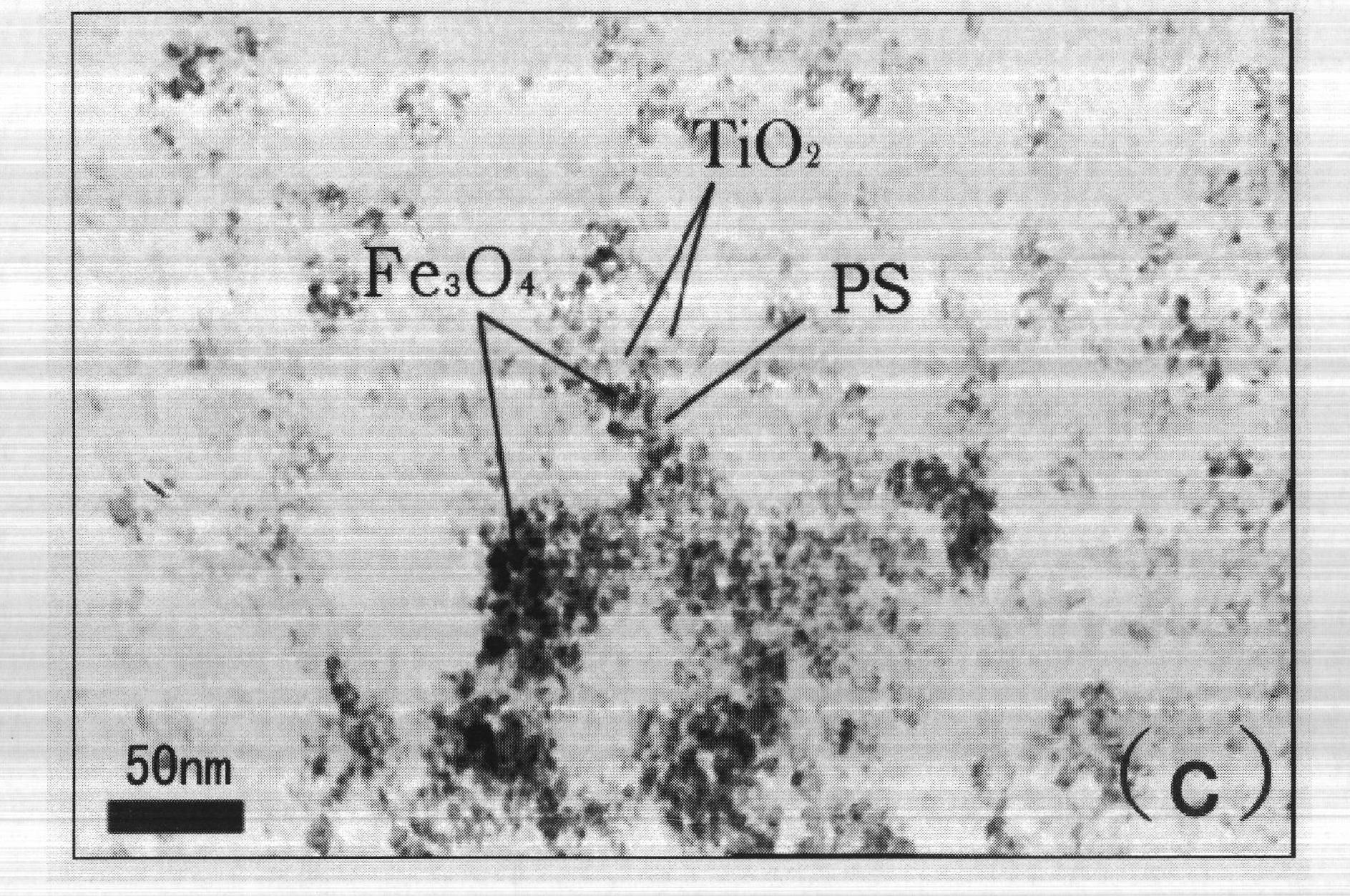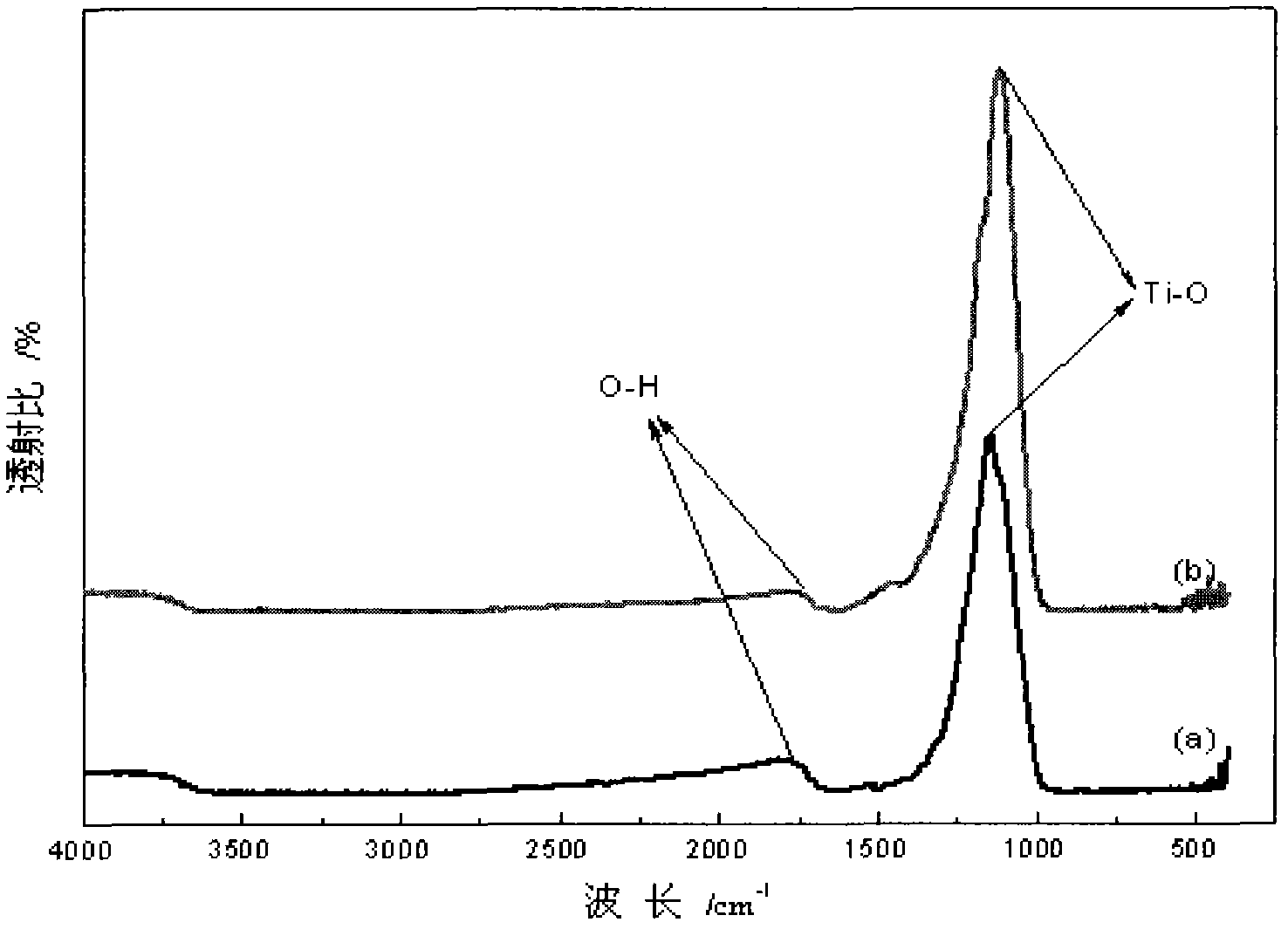Method for preparing TiO2/PS/Fe3O4 magnetic nanoparticle photocatalyst
A technology of magnetic nanoparticles and photocatalysts, applied in the direction of organic compound/hydride/coordination complex catalysts, physical/chemical process catalysts, chemical instruments and methods, etc., can solve the problem of not completely preventing the diffusion of magnetic nuclear substances and reducing saturation Magnetic susceptibility, reducing photocatalytic activity and other issues, to achieve high recycling rate, overcome high energy consumption, and reduce actual operating costs
- Summary
- Abstract
- Description
- Claims
- Application Information
AI Technical Summary
Problems solved by technology
Method used
Image
Examples
Embodiment 1
[0041] Example 1 Preparation of TiO 2 / PS / Fe 3 O 4 The method for magnetic nanoparticle photocatalyst, comprises the following steps:
[0042] (1) Oleic acid modified Fe 3 O 4 Preparation of nanoparticles:
[0043] in N 2 Under protection, the FeCl 3 ·6H 2 O and FeCl 2 4H 2 O was dissolved in deionized water, stirred evenly at 25°C, and NH 3 ·H 2 O, and oleic acid was added to the reaction system, and the reaction was completed to obtain a suspended product. Among them: FeCl 3 ·6H 2 The mass ratio of O to deionized water is 2:100, FeCl 2 4H 2 The mass ratio of O to deionized water is 3:100, NH 3 ·H 2 The volume ratio of O to deionized water is 3:6, and the mass ratio of oleic acid to deionized water is 1:150.
[0044] Heat the suspended product to 60°C and keep it for 25 minutes, then raise the reaction temperature to 90°C, evaporate water and excess ammonia water, and obtain a black precipitate; the black precipitate is filtered with suction, cooled to room ...
Embodiment 2
[0057] Example 2 Preparation of TiO 2 / PS / Fe 3 o 4 The method for magnetic nanoparticle photocatalyst, comprises the following steps:
[0058] (1) Oleic acid modified Fe 3 o 4 Preparation of nanoparticles:
[0059] in N 2 Under protection, the FeCl 3 ·6H 2 O and FeCl 2 4H 2 O was dissolved in deionized water, stirred evenly at 30°C, and NH 3 ·H 2 O, and oleic acid was added to the reaction system, and the reaction was completed to obtain a suspended product. Among them: FeCl 3 ·6H 2 The mass ratio of O to deionized water is 3:200, FeCl 2 4H 2 The mass ratio of O to deionized water is 4:200, NH 3 ·H 2 The volume ratio of O to deionized water is 4:8, and the mass ratio of oleic acid to deionized water is 1:300.
[0060] Heat the suspended product to 80°C and keep it for 35 minutes, then raise the reaction temperature to 95°C, evaporate water and excess ammonia water, and obtain a black precipitate; the black precipitate is filtered with suction, cooled to room ...
Embodiment 3
[0073] Example 3 Preparation of TiO 2 / PS / Fe 3 o 4 The method for magnetic nanoparticle photocatalyst, comprises the following steps:
[0074] (1) Oleic acid modified Fe 3 o 4 Preparation of nanoparticles:
[0075] in N 2 Under protection, the FeCl 3 ·6H 2 O and FeCl 2 4H 2 Dissolve O in deionized water, stir well at 28°C, add NH 3 ·H 2 O, and oleic acid was added to the reaction system, and the reaction was completed to obtain a suspended product. Among them: FeCl 3 ·6H 2 The mass ratio of O to deionized water is 2.5:150, FeCl 2 4H 2 The mass ratio of O to deionized water is 3.5:150, NH 3 ·H 2 The volume ratio of O to deionized water is 3.5:7, and the mass ratio of oleic acid to deionized water is 1:200.
[0076] Heat the suspended product to 70°C and keep it for 30 minutes, then raise the reaction temperature to 93°C, evaporate water and excess ammonia water, and obtain a black precipitate; the black precipitate is filtered with suction, cooled to room temp...
PUM
 Login to View More
Login to View More Abstract
Description
Claims
Application Information
 Login to View More
Login to View More - R&D
- Intellectual Property
- Life Sciences
- Materials
- Tech Scout
- Unparalleled Data Quality
- Higher Quality Content
- 60% Fewer Hallucinations
Browse by: Latest US Patents, China's latest patents, Technical Efficacy Thesaurus, Application Domain, Technology Topic, Popular Technical Reports.
© 2025 PatSnap. All rights reserved.Legal|Privacy policy|Modern Slavery Act Transparency Statement|Sitemap|About US| Contact US: help@patsnap.com



